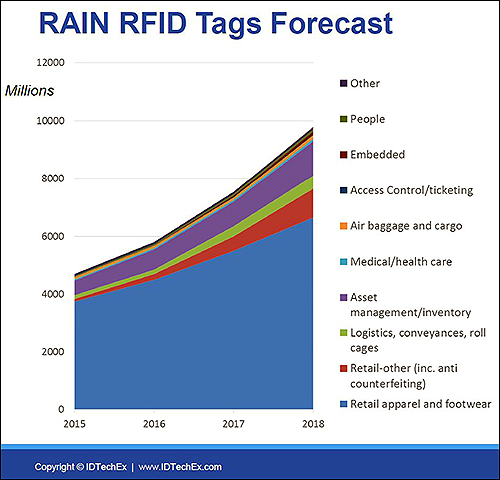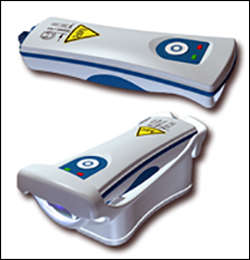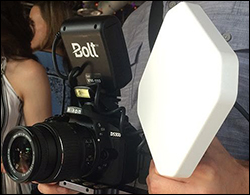The following are news announcements made during the past week by the following organizations:
Jadak;
IDTechEx;
NEC Display Solutions of America, Impinj;
Google;
ParkerVision;
Skytron, and Mobile Aspects.
Jadak Announces New Bluetooth RFID and Bar-code Reader for Health-Care Applications
Jadak, a manufacturer of machine vision, RFID and bar-code scanning products for the health-care and life-sciences industries, has announced the HS-2R, a cordless Bluetooth RFID reader and linear (1D) and matrix (2D) bar-code scanner designed specifically for health care. The HS-2R is designed to help medical technicians improve workflows, according to the company, and is suitable for point of care, blood tracking, drug inventory, reagent scanning, surgical part tracking and more.
The HS-2R, which Jadak says is the world’s first cordless Bluetooth RFID reader and 1D and 2D bar-code scanner designed specifically for health care, reads and writes to 13.56 MHz high-frequency (HF) RFID tags, including those supporting the ISO 14443A, ISO 15693 and ISO 18000-3 standards, as well as the Felica specification. The handheld, which measures 4.6 inches by 2.0 inches by 1.3 inches (116.8 millimeters by 51.3 millimeters by 33.4 millimeters), features a sealed medical-grade housing with an IP 54 rating to protect it from exposure to liquids and multiple drops onto hard hospital floors.
The new dual-function device will be made available later this month, the company reports, and can be tailored to meet specific customer requirements.
RFID Market to Reach $9.56 Billion in 2015, IDTechEx CEO Says
The total RFID market size and outlook for 2015, which includes active RFID and real-time location system (RTLS) technologies, passive RFID services, networking, software, passive RFID interrogators and passive RFID tags, is expected to reach $9.56 billion in 2015, up from $8.73 billion in 2014, according to the presentation made by Raghu Das, IDTechEx‘s CEO, during a recent meeting of the RAIN RFID Alliance.

IDTechEx, headquartered in Cambridge, England, provides market-research reports on a variety of technologies. The RAIN RFID Alliance’s mission is to promote awareness, increase education and support the universal adoption of ultrahigh-frequency (UHF) RFID technology complying with the EPC Gen2v2 UHF RFID specification, incorporated into the ISO 18000-63 standard.
According to Das, applications for retail apparel and shoes using RAIN RFID UHF tags are expected to continue dominating the market growth, with 4.75 billion UHF tags expected to be sold worldwide in 2015. Sales for passive UHF tags is forecast to total $324 million in 2015 (UHF tag sales came in at $241 million in 2013 and $278 million in 2014).
High-frequency (HF) tags for smart cards and payment key fobs captured the greatest market share for cumulative sales, while UHF tags used for retail apparel and consumer packaged goods (CPG) pallet- and case-tracking applications came in second. Applications including smart tickets, the tracking of manufacturing parts and tools, animals (including livestock and pets), and books, and car clicker applications rounded out the top seven.
Approximately 7.5 billion digitally encoded RFID tags were sold worldwide in 2014, according to Das. From 1943 to the start of 2015, a total of 34 billion digitally encoded RFID tags were sold worldwide, IDTechEx estimates. Of those 34 billion, the vast majority—or 33 billion—have been passive tags, while the remainder have been active and/or RTLS tags.
NEC Display Solutions of America Uses Impinj RFID Technology for Contest
During InfoComm 2015, held last month in Las Vegas, NEC Display Solutions of America, a provider of commercial LCD display and projector solutions, used a RAIN RFID-powered digital camera to take photographs of attendees and carry out a contest, according to Impinj. The solution, created by Inmotion, included Impinj’s Indy RS500 reader system in package (SiP) and RFID cards made with Impinj Monza 4QT chips.
Inmotion used an optical cable to link a Nikon D5300 digital SLR camera to a small reader built on the Impinj Indy RS500 SiP. An antenna was attached to the reader and the camera, and the system was designed to register a read event each time the flash went off. As attendees arrived at the party, they were given a RAIN RFID prize card featuring a Monza 4QT tag chip. When the photographer took a picture, the reader registered the read event via a timestamp.
After the party, Impinj reports, the photographer downloaded the pictures, after which the Inmotion software linked the card reads to those photos. The next day, party attendees were able to visit the community wall in the NEC booth, swipe their prize card, view their image on the screen and have a chance to win a prize.
Google Unveils Eddystone Formats for Bluetooth Beacons
Google has announced new technologies aimed at helping developers build apps using Bluetooth-enabled beacons, including a new open format called Eddystone for Bluetooth Low Energy (BLE) beacons to communicate with users’ devices, mechanisms to add meaningful data collected via beacons to apps and to Google services, and a method of managing fleets of beacons efficiently.
A posting on the Google Developers Blog describes Eddystone as an open language for BLE beacons. Eddystone, the blog explains, supports three different frame types for different use cases. The Eddystone-UID frame transmits a beacon’s unique ID number. The Eddystone-URL frame enables a beacon to broadcast a URL, and forms the backbone of Google’s Physical Web concept (see Blesh’s Bluetooth Beacons Take a Sneak Peek at Google’s Physical Web). The Eddystone-TLM (Telemetry) frame uses data obtained by sensors to enable the triggering of various actions, depending on different conditions, such as temperature, air pollution, loudness or humidity. Because the Eddystone-TLM frame does not contain a beacon ID, it must be paired with a frame that provides an ID—either the Eddystone-UID or Eddystone-URL.
Eddystone, which supports versioning to make introducing new functionality easier and works with Android, iOS or any other platform that supports BLE beacons, is available at the GitHub website under the open-source Apache v2.0 license for everyone to use and help improve, the blog post reports. It includes a security feature called Ephemeral Identifiers (EIDs), which change frequently and allow only authorized clients to decode them. According to the blog post, Google will publish the technical specs of this design soon.
Google is launching two application-programming interfaces (APIs) for Eddystone. The Nearby API for Android and iOS is designed to make it easier for apps to find and communicate with nearby devices and beacons, while the Proximity Beacon API lets developers associate semantic location (that is, a place associated with specific latitude and longitude coordinates) and related data with beacons, stored in the cloud.
In the future, according to the blog post, Google plans to introduce a certification process to ensure interoperability among beacons supporting Eddystone. Google says it developed and tested Eddystone with beacon manufacturers to be robust and available at launch, and that beacons capable of being provisioned with Eddystone are available from Bkon, Bluvision, Estimote, Kontakt.io, Radius Networks and Signal360.
Kontakt.io, a startup provider of beacon hardware, as well as back-end and software-development services, has been working on the Eddystone project with Google (referring to Eddystone as Google’s alternative to Apple‘s iBeacon), and is readying its products to support the new format, according to this blog post written by Szymon Niemczura, Kontakt.io’s CEO. Niemczura says the announcement is a “a big deal, because Android is gaining ever-more market share, and it’s been left out in the Internet of Things (IoT) cold for too long.”
ParkerVision’s PV5870 Demodulator Selected for RFID Products, Satellite Receivers, and More
ParkerVision, which is focused on the commercialization of its proprietary RF communication technologies, has announced that one of its component products, the PV5870 wide-band IQ demodulator, is being designed into RFID products, as well as a number of other commercial and industrial RF applications, including satellite receivers and avionics test equipment. The PV5870 is currently being evaluated by additional customers for a wide range of high-performance commercial applications, the company reports.
According to a ParkerVision spokesman, the ultra-low-power, high-performance IQ modulator/demodulator is suitable for both portable and fixed RFID readers. It is designed for typically challenging communication systems, the spokesman says, and features strong linearity and low power consumption of less than 130mW. The device is optimized for wide-band applications utilizing RF carrier frequencies ranging from 400 to 3,600 MHz, and is based on ParkerVision’s patented energy transfer sampling receiver technology and pulse shaping transmitter technology. Benefits include excellent amplitude and phase balance, low conversion loss with low noise figure, very low DC offset, and low power dissipation, ParkerVision says.
ParkerVision reports that it has been shipping evaluation boards and sample components for customers to evaluate and, in some cases, implement in early pilot production units. The firm plans to ship units in volume during the coming months through ParkerVision’s distribution partner, RFMW.
Skytron Inks Deal to Distribute Mobile Aspects’ RFID-Enabled Smart Cabinets
Skytron has announced that it has signed a definitive agreement to distribute Mobile Aspects‘ RFID-enabled smart cabinets for health care, including the iRISupply, iRIScope and iRISecure product lines. Skytron is a medical equipment supplier that provides a full line of health-care products. In addition to RFID asset tracking, the company offers surgical tables, lights, booms, video integration, patient lifts and infection-prevention solutions. The Mobile Aspects products are the latest addition to the Skytron Process Solutions product category designed to increase clinical efficiencies in perioperative and procedural workspaces.
Mobile Aspects’ iRIS suite of solutions is intended to help health-care facilities increase their revenue reimbursement and improve their process and workflow efficiencies, while helping them to comply with regulatory agency guidelines.



